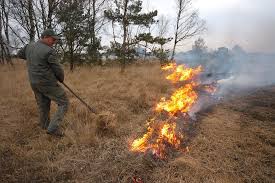In Kenya, Stella Brewer observed that chimpanzees after forest fire search the ground under afzelia trees ((pod) mahogany ) for their beans that raw are too hard to bite through, but roasted can be chewed. The tree trunks continue to smolder more than a week. How great it must have been for our ancestors for a similar step to put raw nuts on a smoldering trunk? Or stitched animals that were not yet well done?
 The assumptions about the domestication of fire diverge. In Xihoudu (Shanxi province, China) is an archaeological site estimated at 1.8 to 1 million years old. There are inter alia found stone tools of hominids, and burned animal remains. According to Glyn Isaac was fire controlled from the Old - Pleistocene (1.5 million - 300,000 BP).
The assumptions about the domestication of fire diverge. In Xihoudu (Shanxi province, China) is an archaeological site estimated at 1.8 to 1 million years old. There are inter alia found stone tools of hominids, and burned animal remains. According to Glyn Isaac was fire controlled from the Old - Pleistocene (1.5 million - 300,000 BP).
Man use apparently a million years ago fire - 600,000 years earlier than has been demonstrated until recent. This is evident from burnt bones and ashes of plants that scientists have discovered in the Wonder Work cave in South Africa (published in 2012).
There is less controversy concerning the use of lichen for fire by Neanderthals about 60,000 years ago. A construction in a deep cave in Bruniquel (southern France) from about 47,600 BP was not possible without lighting.
Analyses on elsewhere found lamps reveal that for the pit conifer and juniper was used. The smell of juniper can also be used as incense. The experiments of De Baune show that moss and lichen are the most suitable.
Fire is one of the earliest and most important milestones in the history of man. The (controlled) use distinguishes us from all other animals.
Fire can ’pre- digest’ food. This opens new food sources, that were too tough, too bitter or even poisonous.
Cook also had a huge impact on the social organization and mentality. Fire control and management requires observation and experimentation. Food preparation requires the collection and temporary storage of food and fuel, keeping a fire burning, protecting it against rain and wind, gently and patiently cooking without burning, waiting for the meal to cool sufficiently. There is a learning process behind, sharing experiences and working together and organize to succeed. For food and preparation the hands were more and more used instead of the teeth and mouth.
Fire also provides warmth in cold periods and regions, and light.
The action range of our ancestors expanded into colder regions (north, or higher in the mountains), to deeper caves, corridors, and mines, and to longer days with more opportunities nearby the heat and light from the fire with communication and things to make.
Fire was also a tool to point and harden sticks, bending antlers and to protect against wildlife.
Jean Auwel brings the origin and life of tribes around their fire (place) beautiful in to live in six readable thick books.
The first forms of agriculture were based on fire culture. By burning of a new field, crops, fed by the minerals obtained from (pot) ash, got the chance to grow. Through a systematic approach over several years sedimentary tribes could meet their food needs.
The fire culture cycles were 50 to 600 years, enough time for nature to recover and to reforest after this human production procedure. There are indications that nearly 50,000 years ago large plots of land were burned in New Guinea to make them more fertile.
The use of fire made many other developments and applications possible. Pottery, metal processing, (al) chemistry, warfare with the scorched earth, offerings to the gods, rites, annual festivals, balefires, and perhaps also their association with hell (and purgatory), gunpowder and fireworks, dynamite, gunfire, steam, fuel engines, smoking, air pollution and deforestation...
The masters of the fire: shamans, potters, blacksmiths and alchemists had in all ancient cultures an aura of magic.
Don Crabtree (Ohio State Museum, 1930) showed that indirect heat treatment (in a sand bath) of flint was used which made processing the stones easier. A delicate work that requires a lot of experience. In France, Bordes mentions application of this technique around 21,000 to 18,000 BP.
Chert (i.a. flint) discolors between 240° and 260°C. The compressive strength becomes thus 40% larger, the tensile strength 45% smaller (similar to hard glass). This made a better quality of tools, especially for symmetrical parts (as arrowheads).
In my youth it was a habit in springtime to burn the tufts of dry grass in the road side to make room (and food) for new and young grass.
Fire culture was also used for battue: to drive wild animals together, or in a ravine.
Scientists (Mark Bonta and Robert Gosford, 2019) confirm what Aboriginals in North Australia have long known: the "firehawks" also use fire culture. By dropping deliberately burning twigs in another area, they flee insects, rodents and reptiles to catch prey more easily. (A form of use of tools.)
